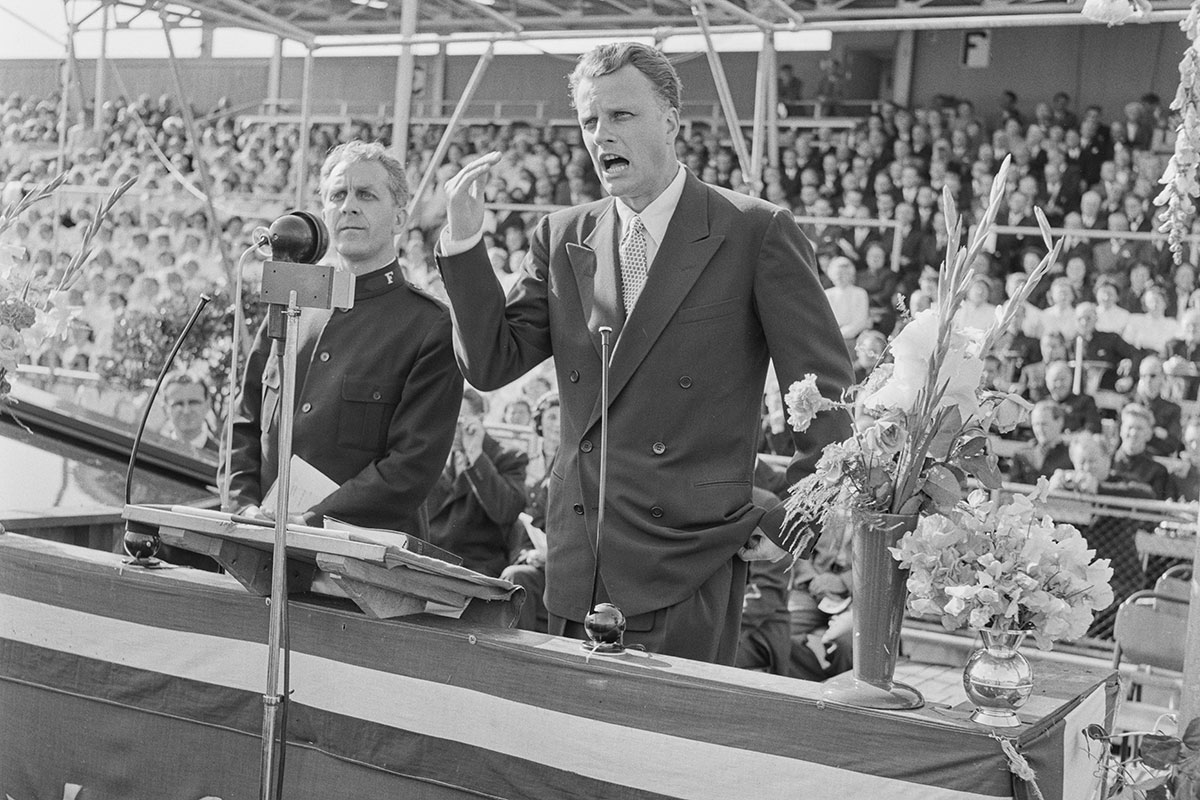We Love You, Billy: A Tribute to Billy Graham by Chancellor Gregory Alan Thornbury
The iconic evangelist died February 21, 2018 at the age of 99.

First published at The Gospel Coalition
“An evangelical,” George Marsden once remarked, “is someone who likes Billy Graham.” If that is the definition, then for today at least, the whole world is evangelical. Throughout his 99 years sojourning planet earth, Graham galvanized believers, rallied evangelical Christians, and humbly pointed them to Jesus. He wanted them to be saved. And that’s all he wanted. When he stood before a stadium of thousands and preached “The Bible says . . .” we believed him. We still believe.
If Carl F. H. Henry was the head of the movement, Billy Graham was its heart. Although we have anticipated this moment for many years, and even as Graham himself has said repeatedly he looked forward to “going home” to be with the Lord and his beloved late wife Ruth, today still comes as a blow. It is hard to lose the heart of a movement. Billy.
There is no adequate way to encapsulate the life of Graham in just a few words. Born to a family of farmers in North Carolina from modest means in 1918, Graham lived a humble life, despite his fame. Flanked by Cliff Barrows and George Beverly Shea, he introduced and explained the Good News to millions through his revival meetings described by a word that now falls oddly upon modern ears: crusade.
He was old school and new school, simultaneously. He understood evangelicals needed to be media savvy. Early on, he took to radio, television, and the silver screen. He understood the centrality of publishing to the evangelical cause, wrote more than two dozen books for laypeople, published Decision magazine, and with his colleague and friend Carl F. H. Henry, started Christianity Today.
Although his reputation as a consensus builder characterized his entire ministry, Graham was no shrinking violet. His voice was prophetic, but he could talk to anybody. He confronted the evils of communism clearly and with conviction. But when he spoke at Union Theological Seminary in New York in 1954 to a faculty and student body who disagreed theologically with him, he reached out to them, and they gave him a warm reception. Graham was full of grace and truth, and never got the order wrong.
Direct Appeal
Consider this example. On July 14, 1950, he kneeled with three of his closest friends to pray. One peculiar aspect distinguished the prayer, however: the venue. The supplication took place just outside the White House in front of the press corps, with the four having just emerged from a half-hour long meeting with the President of the United States. Upon the completion of the prayer, the reporters erupted in mock applause, and Graham answered a barrage of questions. “It began to dawn on me a few days later,” Graham reflected subsequently, “how we had abused the privilege of seeing the President.” But throughout the years, despite admitted failures, Graham’s honesty and sincerity nonetheless won him the close confidence of three presidents, and influence on every living chief executive until the present. He was a Christian whom Christianity Today once dubbed a “modern Mordecai.“
Outside the White House on that summer day, dressed in “ice cream colored suits, hand-painted ties, and white buck shoes” Cliff Barrows, Grady Wilson, Jerry Beavan, and Graham looked like—in Graham’s own words–“a traveling vaudeville team”—an unlikely audience for President Harry Truman. Despite occasional church attendance, Truman privately disdained traditional Christianity, and looked down upon evangelists in particular. Still, he understood that Graham was quickly becoming a national icon and perhaps grudgingly agreed to a meeting. Pleased that Graham had publicly supported his “Truman Doctrine” (which sought to protect Greece and Turkey from falling into the hands of the Soviets), he granted the preacher a hearing in the Oval Office.
Having covered the accounts of his most recent revivals in Los Angeles and Boston, Graham got down to business about the chief executive’s faith. “Mr. President,” Graham ventured, “tell me about your religious background and leanings.” Truman, obviously uncomfortable, vaguely affirmed his allegiance to “the Sermon on the Mount and the Golden Rule.” Unsatisfied with Truman’s statement, Graham confronted his host with the same message he had preached to thousands of others: “It takes more than that, Mr. President. It’s faith in Christ and his death on the cross that you need.” Offended by this direct appeal, Truman stood up as though the meeting were over. Graham asked if the commander in chief would be willing to pray. “It can’t do any harm,” Truman reportedly muttered. The evangelist placed his arm around the president, and offered intercession.
Asked for details on the meeting immediately afterward by an eager press, Graham simply “told them everything I could remember.” He later apologized to the President long after the incident for his terrible lack of judgment in this respect, an apology that Truman “graciously accepted.” “After our gaffe,” Graham wrote in his autobiography, “I vowed to myself it would never happen again if I ever was given access to a person of rank or influence.”
Those opportunities came. His uprightness gave the evangelist unprecedented access with presidents Eisenhower, Johnson, and Nixon. Despite the corruption eventually discovered about the latter two men, one thing remains clear: all three understood Graham’s gospel, even if they did not heed it.
Graham tried to get it right, even when in the eyes of history he sometimes stumbled. Despite an early inconsistent track record on civil rights, he repented and invited Martin Luther King Jr. to join him in the pulpit during his 1957 16-week crusade in New York City. The duo preaching Jesus together boggles the mind. Although MLK later criticized Graham for giving Texas governor Price Daniel, a segregationist, a spot to introduce the evangelist at a crusade in San Antonio in 1958, and despite their pitched disagreement on the Vietnam War, the two reconciled in 1960. That’s what heroes do. So in 1963, when King was jailed after peaceful civil-rights protests in Birmingham, guess who posted bail? Billy.
Out to Get Billy
There is a second part to Marsden’s definition of “evangelical” that I referenced at the beginning of this article. “What’s the difference between an evangelical and a fundamentalist?” Marsden queries. “I have two: a fundamentalist is more conservative than you are. Or, alternatively, a fundamentalist is an evangelical who wants to fight about something.“
Today, there are still fundamentalists out to get Billy: for the way he did evangelism, for his willingness to collaborate with Catholics, or for not being enough of a polemicist. You name it, and they took their shots at him. But Graham was a peacemaker, and today, we believe that his is the kingdom of heaven, just as Jesus promised.
In 1989, Terry Taylor, a musician with long-standing ties to the evangelical world, penned a song that summed up the feelings of so many of us in the generation(s) after Graham’s. Taylor sings:
I don’t know about those other guys
There’s something in the back of their eyes
But Billy, you’re the man who don’t use slight of hand
Ain’t wearing no disguise
I love you, Billy
I love the simple things you say
And you never seem to get in the way
No one is quite like you
Compassionate and true
“Just as I am,” I say
I love you, Billy
Goodbye, Billy Graham. We love you.




